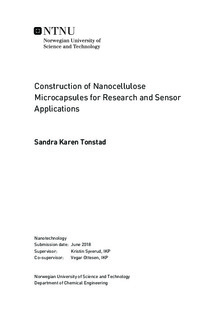Construction of Nanocellulose Microcapsules for Research and Sensor Applications
Master thesis
Permanent lenke
http://hdl.handle.net/11250/2580062Utgivelsesdato
2018Metadata
Vis full innførselSamlinger
Sammendrag
Nanocellulose microcapsules with internal hollows have previously been found to form when cellulose nanofibrils (CNF) are added to paper pulp before drying. In an effort to study such capsules removed from the paper matrix, attempts have been made to develop a production protocol using a aqueous layer-by-layer (LbL) technique. Studying the capsules separately is theorized to expose interesting interface properties as well as provide an opportunity for creation of sensors for use in gaseous environments. Before such possibilities can be investigated, capsules formation must be established. TEMPO-oxidized nanofibrilated cellulose (CNF-T) in combination with PDADMAC were adsorbed around central CaCO3 template particles to form the polyelectrolyte layers. Investigation into the use of freeze-drying with liquid N2 as coolant was done to confirmed this as a viable method for drying the resulting structures. The structures were studied using scanning electron microscopy (SEM), alone or in combination with focused ion beam (FIB) milling. zeta potential measurements show that the alternating layers began forming. Other techniques such as scanning transmission electron microscopy (STEM), optical microscopy and light scattering were also used. Characterization of the starting materials showed the template particles to have an average diameter of approximately 6.3μm. The CNF-T fibrils were determined to have an average diameter of approximately 2.7nm and rheological studies revealed a critical overlap concentration of 0.17% (w/w). The process described in this work provides a first step towards creating layered capsules of CNF-T for use in further research.
